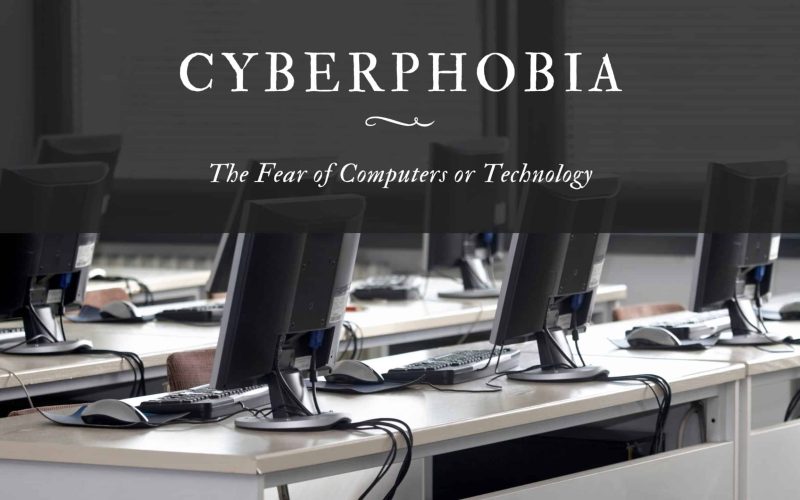Cyberphobia is not a popular term, but it is used to describe an irrational fear of computers or an aversion to computers and new technologies in general.
This term was first introduced in George Orwell’s famous novel, 1984, and many people would argue that this is a very outdated view, and I’m tempted to agree.
But when it comes to kids in today’s world, many adults are seriously concerned about the alarming rise in the use of technology and the effect it will have on these young people.
According to the most recent Ofcom report, there has been more than a double increase in the amount of time kids spend online since 2005.
With 67% of kids between the ages of 5 and 7 and 91% of kids from 8 to 11 years old have access to the internet, there is no argument or that there has been an increase in technology usage.
Parents’ having cyberphobia can be linked to two significant fears in particular.
The first fear is that their children spend too much time staring at a screen instead of being outside playing with the dog or other kids in the fresh air, which many parents believe to be a much better and fruitful use of time and a healthy way of learning.
Many people today would argue that this view is somewhat redundant and that simply because parents played outside when they were younger doesn’t mean that their children must do the same.
Things change, generations move on, which means that the activities which may come off as mindless and dangerous to overly careful and traditional parents in today’s world could be building the passions that will ultimately trigger innovations later in life.
One thing is sure: Everyone knows technology is going nowhere anytime soon. It has already found a way to become intertwined with our everyday lives, and it is only about to become more prevalent at work and home, so rather than fight hard to get children to disengage with it, we should encourage them to embrace it.
The primary thing to remember here is that the major problem here is not the time a child spends on a device; it’s what the child views during that time.
The second major area of concern for parents is the issue of online safety, and this indeed is a much more pressing concern.
The Ofcom study mentioned earlier found that only 27% of guardians or parents usually sit with their kids and watch them online, so it’s only reasonable to worry about what a child views when they are at work or not around.
It is an undeniable fact that technology plays a significant role in cases of bullying both in the neighborhood and in school, as well as the sharing and viewing of inappropriate content. Still, one would not be wrong to argue that technology is not the problem. It only serves as a mere tool, which, like any other, can significantly be misused.
Other people may have this phobia as a result of being brainwashed or conditioned to believe that computers are evil or technology is causing world destruction.
Some school of thought believes the ghetto world was a better place before technological advancement, and computers and the internet are the cause of most of the world’s problems.
Symptoms of Cyberphobia
Just like other phobias, cyberphobia comes with its fair share of physical and psychological symptoms. The most common symptoms include:
- An irrational fear at the thought or sight of a computer, laptop, tablet or smartphone
- Sweating, headache, and panic
- Mood swings and worry when you see a loved one with a computer
- Knowledge of the fact that your fears are unnecessary but feeling powerless over your condition
- Avoiding the use of computers and smart devices
A feeling of concern about children’s activities or how much time you spend on the computer every day is not considered a phobia.
Just like other phobias and anxiety cases, there has to be a continuous fear for at least six months before a diagnosis can be made.
Causes of cyberphobia
No particular cause has been linked to cyberphobia. It could be triggered by almost anything from watching an alien invasion movie where the internet was used as a tool, to belonging to a religion that preaches against technology and the internet or watching a parent avoid computers.
Some slow learners who have found it challenging to catch up with technology and internet usage may develop this phobia if they are bullied for not knowing how to use a computer or smartphone.
Diagnosis of cyberphobia
Cyberphobia is not exactly a common phobia; this diagnosis may be rare. There may also be a misdiagnosis because the symptoms of cyberphobia are similar to those of other phobias.
A doctor or a psychiatrist will have to ask a series of questions to rule out the possibility of other phobias before making a diagnosis.
There is no laboratory test to help with the diagnosis of cyberphobia; thus, psychologists will have to refer to the Diagnostic and Statistical Manual of Mental Disorders (DSM-5) as a guide through the diagnosis.
Treatment of Cyberphobia
There are several treatments used for tackling phobias. The most common is Cognitive behavioral therapy, which helps the patient eliminate their fears and negative thoughts by associating more positive thoughts with the object of their worries.
With time, they will be slowly exposed to the object of their fear until they can feel normal using or being around it. Medications for anxiety may also be prescribed in more severe cases, and sometimes, a combination of both treatment methods may be adopted.
Parents will also be counseled on how to guide their kids through internet use and appropriately use the resources available online.
Parents may be able to restrict access to dangerous sites and restrict the amount of time per day their child gets to use the internet.
Individuals whose cyberphobia is as a result of their lack of knowledge on how to use the internet may take lessons on internet use, and also be offered encouragement and emotional support from family and friends.








